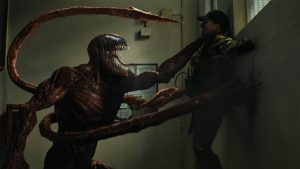April 7, 2023
by Carla Hay

Directed by Kelly Reichardt
Culture Representation: Taking place in Portland, Oregon, the comedy/drama film “Showing Up” features a predominantly white cast of characters (with a few African Americans and Asians) representing the working-class and middle-class.
Culture Clash: An introverted sculptor artist, who works for an arts college, must contend with a variety of challenges, including a difficult landlord, getting her art ready in time for an upcoming exhibit, her divorced parents and a troubled brother with mental health issues.
Culture Audience: “Showing Up” will appeal primarily to people who are fans of star Michelle Williams, filmmaker Kelly Reichardt and realistic movies about neurotic people in quirky communities.

“Showing Up” is right in line with writer/director Kelly Reichardt’s pattern of doing low-key movies about people who are emotionally stifled in some way. The last third movie is not as good as the rest of the film, but it’s still a watchable story. Viewers who are expecting “Showing Up” to have a lot of melodrama, suspenseful action or shocking surprises will be disappointed. In keeping with Reichardt’s filmmaking style, “Showing Up” is a movie about people going about their everyday lives and facing challenges that aren’t that unusual. “Showing Up” had its world premiere at the 2022 Cannes Film Festival and also screened the 2022 New York Film Festival.
Reichardt co-wrote “Showing Up” with Jonathan Raymond after they originally wanted to do a biopic about Canadian artist Emily Carr (who died in 1945, at the age of 73), but Reichardt and Raymond abandoned the idea when they found out how famous Carr is in Canada. Instead, they made “Showing Up” a fictional film about a sculptor artist named Lizzy Carr (played by Michelle Williams), who is not famous and is living a quiet and unassuming life in Portland, Oregon.
Lizzy is a sculptor artist whose day job is working in administration at a small arts college. (The college scenes in “Showing Up” were filmed at now-defunct Oregon College of Art and Craft, which closed in 2019.) Lizzy is introverted and lives by herself. When she’s at home, she prefers to work on her art and doesn’t like being interrupted. Lizzy doesn’t get her art in gallery exhibits very often. And so, the upcoming gallery exhibit that she has is a very big deal for her.
Most of Lizzy’s sculptor pieces are the size of figurines and are often of people sculpted in ragged shapes. Lizzy wants to finish all of her art on time for this exhibit, but several things happen during the course of the story that prevent her for working on her art in the uninterrupted way that she would prefer. “Showing Up” is mostly about how she deals with these challenges, as well as what she learns about herself and her priorities.
In the beginning of the movie, Lizzy is dealing with one of those challenges: her landlord Jo (played by Hong Chau), who is also an artist. Jo has an annoying habit of ignoring or delaying Lizzy’s request to repair things in Lizzy’s rental home. (Jo lives nearby.) One of the movie’s early scenes shows Lizzy becoming irritated with Jo because Lizzy has no hot water for her shower, and Jo has once again been ignoring Lizzy’s requests to fix the shower.
Jo tells Lizzy that Lizzy can use Jo’s shower in the meantime. But that’s not the point. Lizzy is paying Jo rent to have working utilities in the home. Jo isn’t keeping her end of the deal as a landlord. Lizzy comments to Jo, “You’re not the only person with a deadline.” Jo’s replies, “I know, but I have two showers, which is in insane.”
Lizzy’s art in the movie was made in real life by Cynthia Lahti. Jo’s installation-sized art in the movie was made in real life by Michelle Segre. The sizes of art pieces are meant to reflect the different personalities of Lizzy and Jo. Lizzy is quiet and unassuming. Jo is extroverted and likes to call attention to herself.
Lizzy has some other issues in her life. Her mother Jean (played by Maryann Plunkett) is also her boss at work. Jean and Lizzy sometimes have disagreements that on the surface seem to be about work, but they’re really about unspoken resentments that Lizzy and Jean have toward each other. Jean thinks Lizzy is stubborn, while Lizzy thinks Jean is too demanding. Their conflicts aren’t major, but they’re enough to make the relationship slightly strained.
A lot of this mother-daughter friction has to do with how Lizzy has been affected by her parents’ divorce. Jean uses Lizzy as a go-between to communicate with Lizzy’s free-spirited father Bill (played by Judd Hirsch), who is very different from uptight and rigid Jean. Bill has let a random bohemian couple named Dorothy (played by Amanda Plummer) and Lee (played by Matt Malloy) live with Bill in his home, shortly after he met them. Dorothy and Lee, who are from Canada, say they’re just “visiting,” but they haven’t told Bill when they’ll be leaving.
Jean thinks that Bill is being taken advantage of by this couple, because she’s pretty sure these new housemates are not giving Bill any compensation for his hospitality. Because Jean is Bill’s ex-wife and no longer lives with him, she doesn’t have a say on how he lives his life. However, Jean is pressuring Lizzy to talk to Bill about his living arrangement with these two new housemates. Lizzy doesn’t really want to get involved, so she resents that her mother is trying to use her as a pawn.
Meanwhile, Lizzy has a younger brother named Sean (played by John Magaro), who’s been struggling with mental health issues, which have led to him being homeless at various times in his life. Jean is in deep denial about Sean’s mental health issues. Jean thinks Sean is a “genius” who doesn’t need psychiatric help, while Lizzy has a completely opposite opinion.
When Sean has a big scene in a certain part of the movie, “Showing Up” falters because it just looks like awkward slapstick comedy. “Showing Up” loses a lot of emotional resonance in this scene where the movie could have been had its strongest and most meaningful impact. And frankly, it seems like this mentally ill character is just used in the most negative, stereotypical ways, instead of treating this character as a well-rounded person.
Another wasted opportunity was in casting André Benjamin as Eric, Lizzy’s friendly co-worker who is a kiln master at the college. Benjamin shares headlining billing for this movie, but you wouldn’t know it, based it on how little screen time he has (less than 10 minutes) and how Eric ends up being a character who is completely inconsequential to any storyline in the movie. Quite frankly, Eric looks like a token character in “Showing Up,” as if the filmmakers wanted to show the audience: “Look, we gave an African American a speaking role the movie to make our cast look racially diverse.”
“Showing Up” also has a few subplots that might induce boredom with some viewers. Lizzy takes care of a wounded bird with a broken wing, after Jo finds the bird and hands off the responsibility of taking care of it to Lizzy. At least the wounded bird subplot (which is obvious symbolism for how Lizzy feels) actually has a purpose for the story—unlike a meandering and flimsy subplot about Lizzy and her co-workers having to accommodate an artist in residence named Marlene Heyman (played by Heather Lawless), who is diva-like and has many star-struck fans at the school.
“Showing Up” greatly benefits from having talented cast members (especially Williams and Chau), who make the movie’s characters believable when less-skilled cast members wouldn’t have been able to do the same thing. There have been many movies made about mopey male artists who’ve dedicated themselves so completely to their art, it’s affected their personal lives. Not many movies are made about this type of female artist, so viewers might have varying reactions to Lizzy’s less-than-charismatic personality. “Showing Up” is a well-acted story about the reality of most artists’ lives: far from glamorous, struggling in obscurity, and trying to be their definition of personal greatness.
A24 released “Showing Up” in select U.S. cinemas on April 7, 2023.


